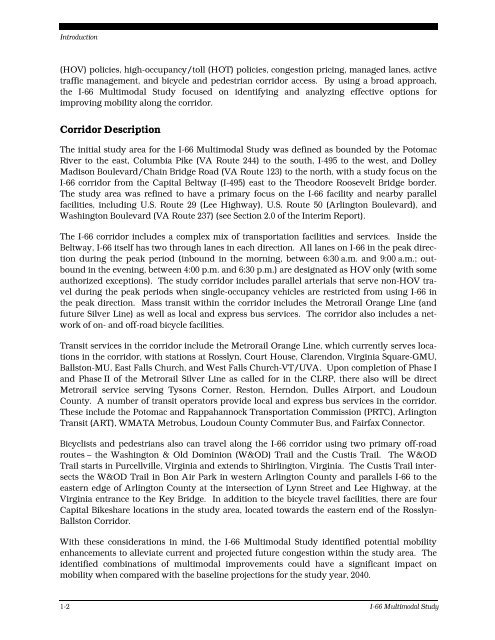I-66 Multimodal Study Final Report - Virginia Department of ...
I-66 Multimodal Study Final Report - Virginia Department of ...
I-66 Multimodal Study Final Report - Virginia Department of ...
- No tags were found...
Create successful ePaper yourself
Turn your PDF publications into a flip-book with our unique Google optimized e-Paper software.
Introduction(HOV) policies, high-occupancy/toll (HOT) policies, congestion pricing, managed lanes, activetraffic management, and bicycle and pedestrian corridor access. By using a broad approach,the I-<strong>66</strong> <strong>Multimodal</strong> <strong>Study</strong> focused on identifying and analyzing effective options forimproving mobility along the corridor.Corridor DescriptionThe initial study area for the I-<strong>66</strong> <strong>Multimodal</strong> <strong>Study</strong> was defined as bounded by the PotomacRiver to the east, Columbia Pike (VA Route 244) to the south, I-495 to the west, and DolleyMadison Boulevard/Chain Bridge Road (VA Route 123) to the north, with a study focus on theI-<strong>66</strong> corridor from the Capital Beltway (I-495) east to the Theodore Roosevelt Bridge border.The study area was refined to have a primary focus on the I-<strong>66</strong> facility and nearby parallelfacilities, including U.S. Route 29 (Lee Highway), U.S. Route 50 (Arlington Boulevard), andWashington Boulevard (VA Route 237) (see Section 2.0 <strong>of</strong> the Interim <strong>Report</strong>).The I-<strong>66</strong> corridor includes a complex mix <strong>of</strong> transportation facilities and services. Inside theBeltway, I-<strong>66</strong> itself has two through lanes in each direction. All lanes on I-<strong>66</strong> in the peak directionduring the peak period (inbound in the morning, between 6:30 a.m. and 9:00 a.m.; outboundin the evening, between 4:00 p.m. and 6:30 p.m.) are designated as HOV only (with someauthorized exceptions). The study corridor includes parallel arterials that serve non-HOV travelduring the peak periods when single-occupancy vehicles are restricted from using I-<strong>66</strong> inthe peak direction. Mass transit within the corridor includes the Metrorail Orange Line (andfuture Silver Line) as well as local and express bus services. The corridor also includes a network<strong>of</strong> on- and <strong>of</strong>f-road bicycle facilities.Transit services in the corridor include the Metrorail Orange Line, which currently serves locationsin the corridor, with stations at Rosslyn, Court House, Clarendon, <strong>Virginia</strong> Square-GMU,Ballston-MU, East Falls Church, and West Falls Church-VT/UVA. Upon completion <strong>of</strong> Phase Iand Phase II <strong>of</strong> the Metrorail Silver Line as called for in the CLRP, there also will be directMetrorail service serving Tysons Corner, Reston, Herndon, Dulles Airport, and LoudounCounty. A number <strong>of</strong> transit operators provide local and express bus services in the corridor.These include the Potomac and Rappahannock Transportation Commission (PRTC), ArlingtonTransit (ART), WMATA Metrobus, Loudoun County Commuter Bus, and Fairfax Connector.Bicyclists and pedestrians also can travel along the I-<strong>66</strong> corridor using two primary <strong>of</strong>f-roadroutes – the Washington & Old Dominion (W&OD) Trail and the Custis Trail. The W&ODTrail starts in Purcellville, <strong>Virginia</strong> and extends to Shirlington, <strong>Virginia</strong>. The Custis Trail intersectsthe W&OD Trail in Bon Air Park in western Arlington County and parallels I-<strong>66</strong> to theeastern edge <strong>of</strong> Arlington County at the intersection <strong>of</strong> Lynn Street and Lee Highway, at the<strong>Virginia</strong> entrance to the Key Bridge. In addition to the bicycle travel facilities, there are fourCapital Bikeshare locations in the study area, located towards the eastern end <strong>of</strong> the Rosslyn-Ballston Corridor.With these considerations in mind, the I-<strong>66</strong> <strong>Multimodal</strong> <strong>Study</strong> identified potential mobilityenhancements to alleviate current and projected future congestion within the study area. Theidentified combinations <strong>of</strong> multimodal improvements could have a significant impact onmobility when compared with the baseline projections for the study year, 2040.1-2 I-<strong>66</strong> <strong>Multimodal</strong> <strong>Study</strong>
















